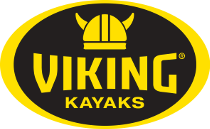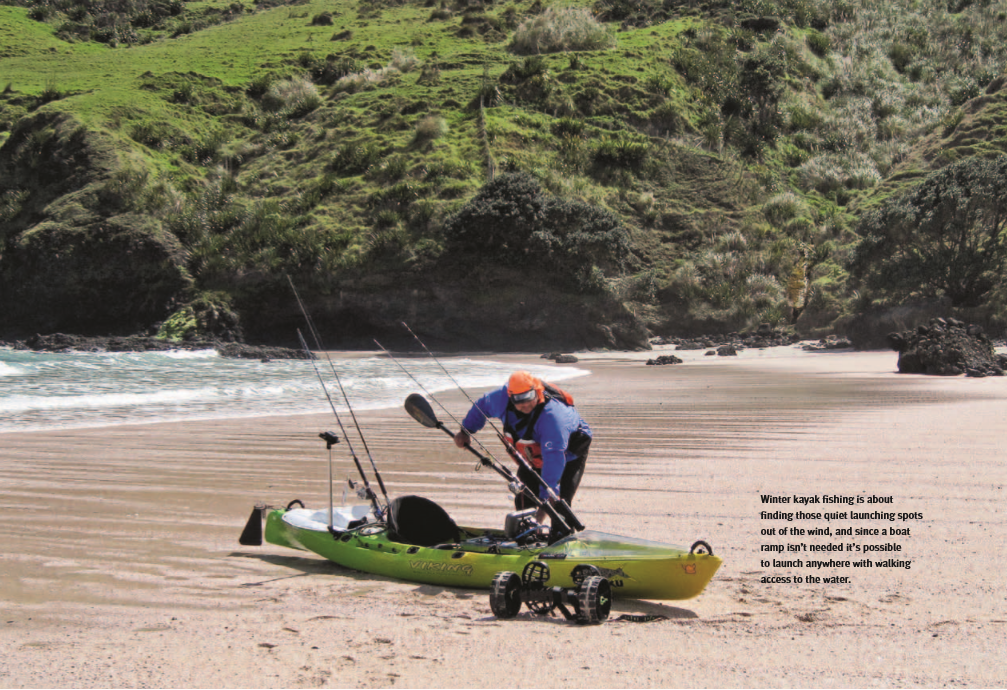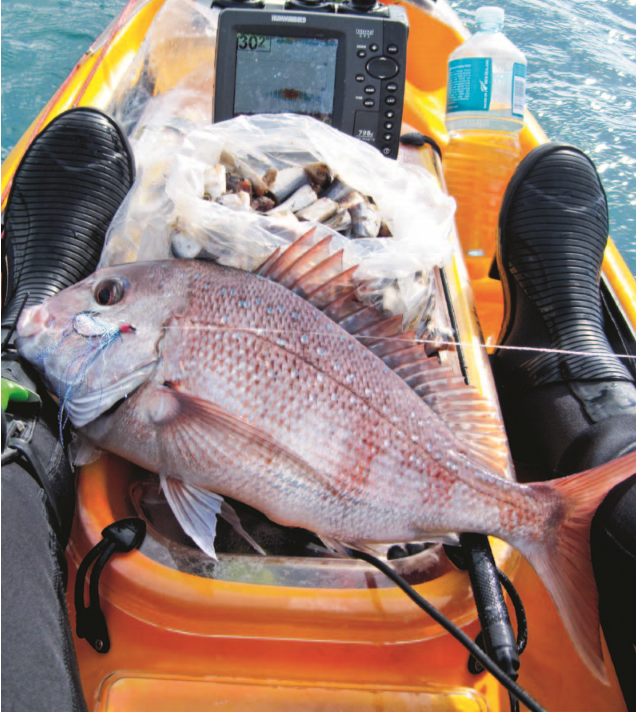The Big Berley Bash
3:11PM 1st Oct 13
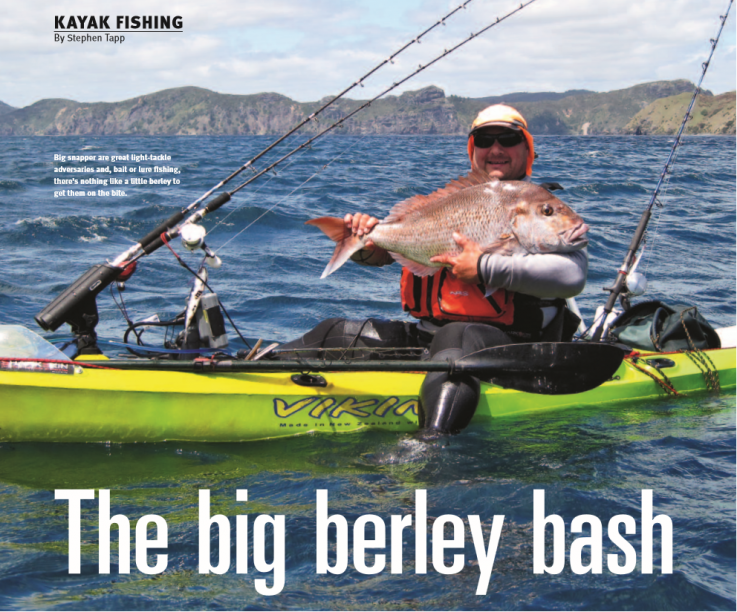
Big snapper are great light-tackle adversaries and, bait or lure fishing, there’s nothing like a little berley to get them on the bite.
Most fishers I know are familiar with berleying concepts. It’s certainly a regular topic of discussion amongst land-based and boating anglers back at the club, but a less common practice amongst kayak anglers. In part this is due to many fishers almost entirely adopting lure-fishing methods (soft-baits and slow-jigs in particular), which are considered drift-fishing techniques and where berleying isn’t necessary (berleying and cubing is best done from anchor or over an extremely slow drift). In reality, though, I’ve had some great successes lazily working lures through berley trails.
Another reason many kayak anglers avoid using berley is the assumption it’s a messy procedure, when in fact all it takes is a little organization to keep the decks clean. Whatever the viewpoint, it’s certainly a favored strategy of mine during fishing competitions, so let’s look at a couple of options and see how they can work:
Berley options
I really like to actively paddle around and hunt the change-of-light periods at either end of the day if conditions allow, but fishing during the middle of the day often needs something to kick-start it. Of course, if wind and swell are stopping us from getting very far afield, we’ll need to do something to bring the fish to us, since we can’t go to them.
Frozen berley systems are incredibly effective in such circumstances, sending out lots of oily scents and tiny fish bits to ring the dinner bell for any self- respecting snapper. The problem for kayakers is that thawing berley is often very hard to contain, and a messy deck is almost inevitable. On the Profish 440 I utilize one of the bait-wells behind the seat to great effect. They’re just the right size to accommodate small- to medium-sized berley bombs in an onion sack, and make quickly lifting bags over the side easy and mess free.
Most kayaks don’t have this feature though, and bringing a rapidly-thawing berley bag on deck can create problems – unless you’ve made the effort to carry a bucket for the purpose. The way round this is to use a dry berley system. This can take several forms, or you can mix them up to combine the advantages of each.
The compressed berley sausage
The classic example here is the Berley Mate system, a compressed mixture of cereals containing fish oils and flavours in rapid-release and long-life forms. Compact, effective and really easy to manage due to the small size of the sausages, this is a really effective system for kayakers. So, when paddling kayaks without dedicated bait wells, I carry a plastic bag to stow the loaded onion/berley sack in (kept from the water, the Berley Mate sausages stop dissolving and can be reused).
My preference is for the rapid-release version, or if I’m on an extended session I add one of the slow-release ‘LongLife’ versions as well; this gives a solid berley trail that won’t run out in a hurry. One downside is that many retailers don’t seem to stock this type of berley any more. Fortunately it has a long shelf life, so when you find a stockiest it’s practical and worthwhile to get a few extras for later.
‘Berley Bites’ pellets
This is becoming a favorite of mine for shorter trips, being a pelletized mixture of fish meal, meat, bone, fish oil and wheat. Not unlike the Berley Mate sausage in composition, the biggest difference is the pellet form; this greatly increases the surface area exposed in the water and makes for considerably faster dispersal. Consequently the system is very good for rapidly establishing a trail, especially if you don’t intend to be there for long.
However, this means the pellets are much messier to bring aboard and they will continue to break down if stowed wet in a plastic bag (though the resulting goo is excellent when dished in dollops over the side). I get around this by pre-bagging the pellets into smaller lots to keep them dry, then adding fresh lots into the berley sack as required.
Dog roll/cat food
This is my emergency berley when the other systems aren’t available. It’s not as good at giving out little fragments and pieces to keep baitfish interested, so it’s often a good idea to break the sausage into lots of pieces to expose more of it to the water. It also takes lots of shaking in the water to be effective, but can be better than nothing. The advantages are that it doesn’t make too much mess if brought aboard to relocate, and it can be the perfect accompaniment to the Berley Bites above, which can dissolve too rapidly, causing a break in the berley trail.
Getting the berley where you need it
This topic is often discussed by anglers fishing from bigger boats, and though we can use similar techniques, fishing from kayaks adds a complication. Unfortunately, our craft rarely hold down-current of the anchor in the same way a bigger boat does. More often we sit down-wind of the anchor with the current flowing in a different direction. This means a berley trail from a bag on top of the anchor can be significantly off to one side of the kayak and a very long way from where our baits are drifting.
For this reason I now prefer to hang the berley off the side of the kayak, usually a couple of metres down. This makes it simple to keep baits and lures in the trail, where they’re most likely to attract attention. If in deep water or an area with lots of current, I’ll add a heavy weight to the berley line to get it to the depth required.
One point worth noting: on occasion berley can attract unwanted toothy critters, so it’s wise to be prepared should one grab the bag/container. I use a release clip at the side of the kayak, making it very easy to trip the line free if needed. If you don’t use a clip, make sure the line is tied with a slip knot in such a way it won’t hang up when being released.
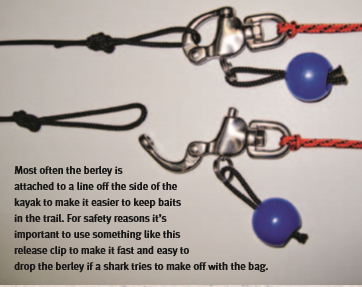
Cubing/chunking
An alternative to berleying is cubing. I use this technique to great effect in water that’s too deep for surface berleying . The advent of pre-cut pillie cubes has made a huge difference to using this technique from kayaks; simply grab a bag from the freezer, smash it on the ground to free-flow it, then let it thaw along with your bait, and you’re ready to go. So much cleaner that trying to create your own cubes when sitting out on the water.
A couple of hints: make sure the cubes are thawed or it can be difficult to get them to sink properly, and don’t get too enthusiastic with throwing them around. I’ve had my best success by slowly dropping them off the side of the kayak so just two or three can be seen at any one time before disappearing into the depths. It’s then easy to keep the trail uninterrupted and to periodically drift a bait or lightly weighted lure down the same track as the cubes. At times it can be startling to realize you have a big moocher right up under the kayak almost eating the cubes from your fingertips!
This is what cubing is all about: a nice fat panny for the table – and a big school of willing takers waiting for the next bait showing on the sounder.
